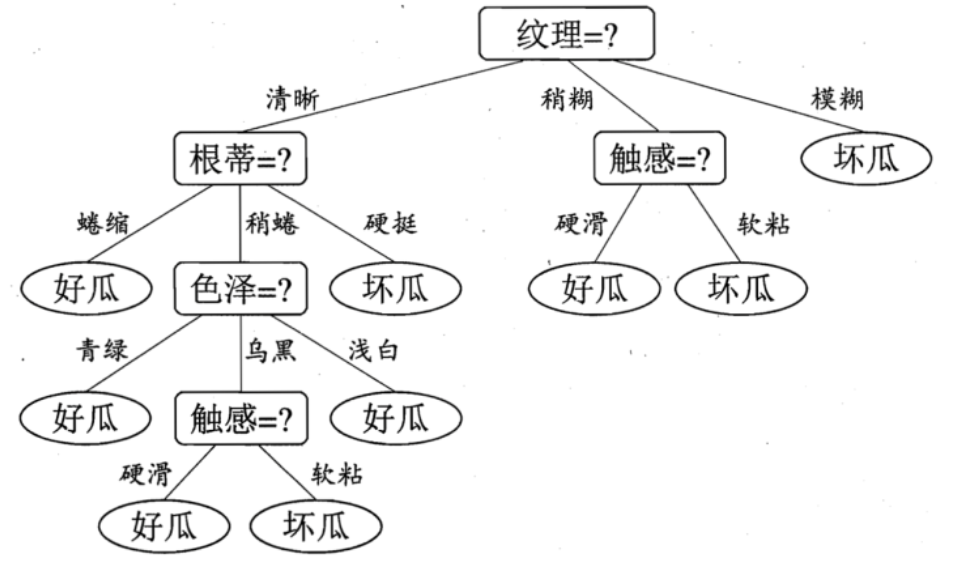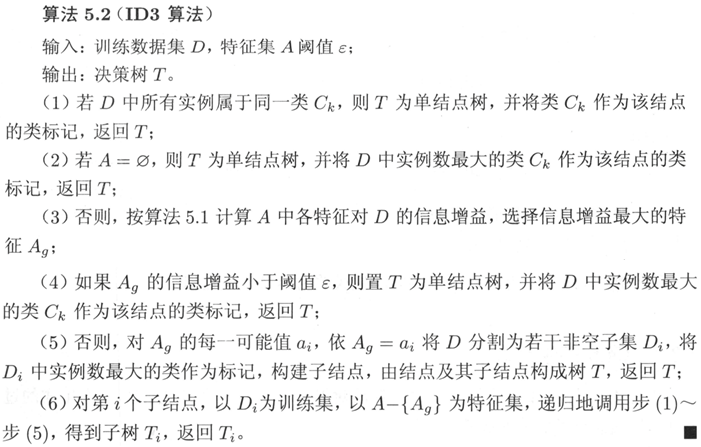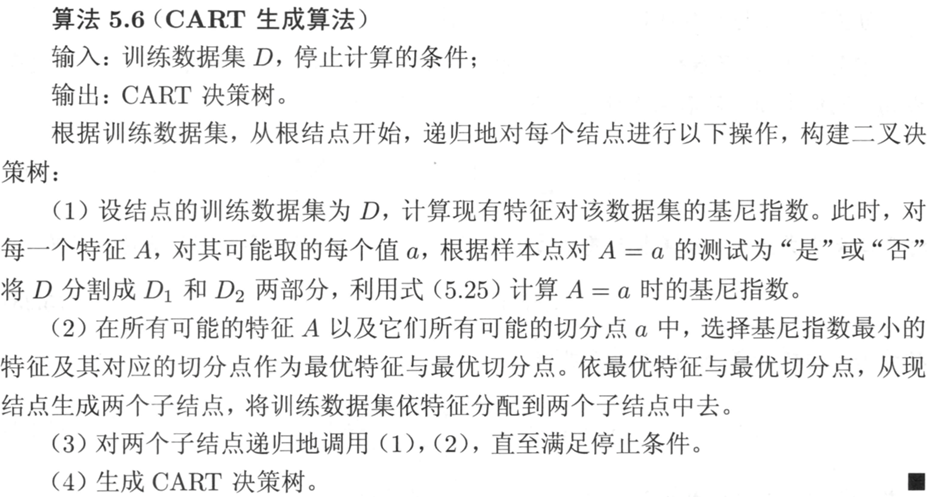决策树(ID3、C4.5、CART算法numpy实现)
什么是决策树?
决策树(decision tree)是一个树结构(可以是二叉树或非二叉树)。
其每个非叶节点表示一个特征属性上的测试,每个分支代表这个特征属性在某个值域上的输出,而每个叶节点存放一个类别。
使用决策树进行决策的过程就是从根节点开始,测试待分类项中相应的特征属性,并按照其值选择输出分支,直到到达叶子节点,将叶子节点存放的类别作为决策结果。

(图片来源)
如何建树?
建树的关键在于特征选择,我们应当选择怎么样的特征作为我们的判断条件。
大致有三种算法:
1、ID3算法:基于信息增益准则选择特征
2、C4.5算法:基于信息增益比来选择特征
3、CART算法:基于基尼指数来选择特征
1、ID3算法:
如何计算信息增益:

K是分类值y的种类,| |表示样本数量,n表示特征A所有可能的取值(这句话的意思是枚举所有在训练集出现过的值,即使在某层中该取值的样本数为0)。
例如:(图片来源)

ID3算法流程如下:

代码实现:
使用信息增益进行特征选择的缺点:偏向于选择取值较多的特征,可以理解为倾向划分更多的子树。

import numpy as np from math import log2 as log class TreeNode(object): def __init__(self,X,Y,S): self.label = None self.divide_dim = None self.X = X self.Y = Y self.children = {} self.is_leaf = True self.source =S #为了display函数 self.id = None #节点ID,确保唯一 self.child_ids =[] class DecisionTree(object): def __init__(self,X,Y,function='ID3'): self.X = X self.Y = Y self.F = function self.num_features = len(X[0]) #特征数 self.feature_map = {} #特征映射为int值 self.maps = {} #每个特征中对应的值的映射,例如第二个特征,有一个叫‘是’,那么maps[1]['是']=0/1 self.label_map = {} #y 标签映射为数值 self.root = None self.epsilon = 0 self.inv_maps={} self.ID = 1 def train(self): # train函数主要是处理数据,把所有特征转化为数值型,方便使用numpy处理 X = self.X Y = self.Y # X row = Y row +1 # 默认X的第一行为特征描述 features = X[0] xx = np.zeros([len(X),self.num_features],dtype=int) yy = np.zeros(len(Y),dtype=int) for feature,j in zip(features,range(self.num_features)): self.feature_map[feature] = j self.maps[j] ={} self.inv_maps[j]={} for i in range(1,len(X)): k = X[i][j] if k in self.maps[j].keys(): xx[i][j] = self.maps[j][k] else: self.maps[j][k] = len(self.maps[j]) xx[i][j] =self.maps[j][k] self.inv_maps[j][xx[i][j]]=k for i in range(len(Y)): k= Y[i] if k in self.label_map.keys(): yy[i] = self.label_map[k] else: self.label_map[k] = len(self.label_map) yy[i] = self.label_map[k] xx = xx[1:] X = X[1:] # xx , yy all int self.root = TreeNode(xx,yy,xx) self.root.id = self.ID self.ID = self.ID+1 print(self.root.X) print(self.root.Y) self.build_tree(self.root) def get_information_gain(self,X,Y,dim,idx): # dim 表示特征索引 nums = X.shape[0] cnt_class = len(self.label_map) cnt_x = len(self.maps[dim]) xx = X[:,dim] yy = Y hd =0 for v in range(cnt_class): nums_v = np.where(yy==v,1,0).sum() if nums_v >0 : hd = hd - nums_v*log(nums_v/nums)/nums hda = 0 for i in range(cnt_x): di = np.where(xx==i,1,0).sum() if di>0: tmpy=yy[np.where(xx==i,True,False)] for k in range(cnt_class): dik = np.where(tmpy== k,1,0).sum() if dik >0: hda = hda - (di/nums)*(dik/di)*log(dik/di) # 显示当前节点计算的指定维度的信息增益 inv_feature_map = dict(zip(self.feature_map.values(), self.feature_map.keys())) print('当前节点序号: ', idx, ' 特征: ', inv_feature_map[dim]) print('information gain', hd - hda) return hd-hda def build_tree(self,root): if self.check_all_y(root.Y): #所有实例属于同一类 root.is_leaf=True root.label = root.Y[0] elif self.check_X_null(root.X): #特征为空,无法进一步选择划分,标记为-1的列即表示已经使用过 root.is_leaf=True root.label = self.get_max_y(root.Y) else: epsilon = self.epsilon #epsilon mx_dim = -1 #选取信息增益最大的作为特征维度 for dim in self.maps.keys(): if root.X[0,dim] != -1: gda = self.get_information_gain(root.X,root.Y,dim,root.id) if gda > epsilon: epsilon =gda mx_dim=dim if mx_dim == -1: root.is_leaf = True root.label = self.get_max_y(root.Y) else: root.divide_dim = mx_dim root.is_leaf = False root.label = self.get_max_y(root.Y) xx = root.X yy = root.Y for i in range(len(self.maps[mx_dim])): tmpx = xx[np.where(xx[:,mx_dim]==i,True,False)] tmps = root.source[np.where(xx[:, mx_dim] == i, True, False)] tmpx[:,mx_dim] =-1 #将使用过的特征标记为-1 tmpy = yy[np.where(xx[:,mx_dim]==i,True,False)] child = TreeNode(tmpx,tmpy,tmps) child.id = self.ID self.ID = self.ID + 1 root.child_ids.append(child.id) root.children[i] = child if tmpx.shape[0] == 0: #如果为空集,子节点的类别和当前节点保持一致 child.is_leaf=True child.label = root.label else: child.is_leaf=False child.X = tmpx child.Y = tmpy self.build_tree(child) pass def check_all_y(self,Y): yy = Y - Y[0] if np.where(yy==0,0,1).sum()==0: return True else: return False def check_X_null(self,X): if np.where(X==-1,0,1).sum()==0: return True else: return False def get_max_y(self,Y): #选取最大类别 mx = 0 for k in range(len(self.label_map)): dk = np.where(Y == k, 1, 0).sum() if mx < dk: label = k mx = dk return label def display(self): mp = dict(zip(self.label_map.values(),self.label_map.keys())) inv_feature_map = dict(zip(self.feature_map.values(), self.feature_map.keys())) q= [] q.append(self.root) while len(q)>0: root = q[0] c= q.pop(0) if root.is_leaf: print(root.id, mp[root.label],' is leaf') ss = [] for idx in range(root.source.shape[0]): s = root.source[idx] sen = [] for i in range(s.shape[0]): sen.append(self.inv_maps[i][s[i]]) ss.append(sen) print(ss) else : print(root.id, 'divide dim ', inv_feature_map[root.divide_dim], '*' * 20) print(root.child_ids) ss = [] for idx in range(root.source.shape[0]): s = root.source[idx] sen = [] for i in range(s.shape[0]): sen.append(self.inv_maps[i][s[i]]) ss.append(sen) print(ss) for i in range(len(self.maps[root.divide_dim])): q.append(root.children[i]) pass def _predict(self,root,x): dim = root.divide_dim if root.is_leaf: return root.label if x[dim] not in self.maps[dim].keys(): return self.root.label return self._predict(root.children[self.maps[dim][x[dim]]], x) def predict(self,x): pred_label = self._predict(self.root,x) for k,v in self.label_map.items(): if v==pred_label: return k # X = [[1,2,3,4,5,6],['青年','否','一般'],['青年','否','好'],['青年','是','好'],['青年','是','一般'], # ['青年','否','一般'],['中年','否','一般'],['中年','否','一般'], # ['中年','是','好'],['中年','否','一般']] # y = ['否','否','是','是','否','否','否','是','是'] X = [['色泽','根蒂','敲声','纹理','脐部','触感'], ['青绿','蜷缩','沉闷','清晰','凹陷','硬滑'], ['浅白','蜷缩','浊响','清晰','凹陷','硬滑'], ['乌黑','稍蜷','浊响','清晰','稍凹','硬滑'], ['乌黑','稍蜷','沉闷','稍糊','稍凹','硬滑'], ['浅白','硬挺','清脆','模糊','平坦','硬滑'], ['浅白','蜷缩','浊响','模糊','平坦','软粘'], ['青绿','稍蜷','浊响','稍糊','凹陷','硬滑']] y = ['是','是','是','否','否','否','否'] dt = DecisionTree(X,y) dt.train() dt.display() # 新增加了决策树的预测函数 print(dt.predict(['青绿','稍蜷','浊响','稍糊','非常平坦','硬滑']))

1 import numpy as np
2 from math import log2 as log
3 class TreeNode(object):
4 def __init__(self,X,Y,S):
5 self.label = None
6 self.divide_dim = None
7 self.X = X
8 self.Y = Y
9 self.children = {}
10 self.is_leaf = True
11 self.source =S #为了display函数
12 self.id = None #节点ID,确保唯一
13 self.child_ids =[]
14
15 class DecisionTree(object):
16 def __init__(self,X,Y,function='ID3'):
17 self.X = X
18 self.Y = Y
19 self.F = function
20 self.num_features = len(X[0]) #特征数
21 self.feature_map = {} #特征映射为int值
22 self.maps = {} #每个特征中对应的值的映射,例如第二个特征,有一个叫‘是’,那么maps[1]['是']=0/1
23 self.label_map = {} #y 标签映射为数值
24 self.root = None
25 self.epsilon = 0
26 self.inv_maps={}
27 self.ID = 1
28
29 def train(self):
30 # train函数主要是处理数据,把所有特征转化为数值型,方便使用numpy处理
31 X = self.X
32 Y = self.Y
33 # X row = Y row +1
34 # 默认X的第一行为特征描述
35 features = X[0]
36 xx = np.zeros([len(X),self.num_features],dtype=int)
37 yy = np.zeros(len(Y),dtype=int)
38 for feature,j in zip(features,range(self.num_features)):
39 self.feature_map[feature] = j
40 self.maps[j] ={}
41 self.inv_maps[j]={}
42 for i in range(1,len(X)):
43 k = X[i][j]
44 if k in self.maps[j].keys():
45 xx[i][j] = self.maps[j][k]
46 else:
47 self.maps[j][k] = len(self.maps[j])
48 xx[i][j] =self.maps[j][k]
49 self.inv_maps[j][xx[i][j]]=k
50
51 for i in range(len(Y)):
52 k= Y[i]
53 if k in self.label_map.keys():
54 yy[i] = self.label_map[k]
55 else:
56 self.label_map[k] = len(self.label_map)
57 yy[i] = self.label_map[k]
58 xx = xx[1:]
59 X = X[1:]
60 # xx , yy all int
61 self.root = TreeNode(xx,yy,xx)
62 self.root.id = self.ID
63 self.ID = self.ID+1
64 print(self.root.X)
65 print(self.root.Y)
66 self.build_tree(self.root)
67
68 def get_information_gain(self,X,Y,dim,idx):
69 # dim 表示特征索引
70 nums = X.shape[0]
71 cnt_class = len(self.label_map)
72 cnt_x = len(self.maps[dim])
73 xx = X[:,dim]
74 yy = Y
75 hd =0
76 for v in range(cnt_class):
77 nums_v = np.where(yy==v,1,0).sum()
78 if nums_v >0 :
79 hd = hd - nums_v*log(nums_v/nums)/nums
80 hda = 0
81 for i in range(cnt_x):
82 di = np.where(xx==i,1,0).sum()
83 if di>0:
84 tmpy=yy[np.where(xx==i,True,False)]
85 for k in range(cnt_class):
86 dik = np.where(tmpy== k,1,0).sum()
87 if dik >0:
88 hda = hda - (di/nums)*(dik/di)*log(dik/di)
89 # 显示当前节点计算的指定维度的信息增益
90 inv_feature_map = dict(zip(self.feature_map.values(), self.feature_map.keys()))
91 print('当前节点序号: ', idx, ' 特征: ', inv_feature_map[dim])
92 print('information gain', hd - hda)
93 return hd-hda
94
95 def build_tree(self,root):
96 if self.check_all_y(root.Y): #所有实例属于同一类
97 root.is_leaf=True
98 root.label = root.Y[0]
99 elif self.check_X_null(root.X): #特征为空,无法进一步选择划分,标记为-1的列即表示已经使用过
100 root.is_leaf=True
101 root.label = self.get_max_y(root.Y)
102 else:
103 epsilon = self.epsilon #epsilon
104 mx_dim = -1 #选取信息增益最大的作为特征维度
105 for dim in self.maps.keys():
106 if root.X[0,dim] != -1:
107 gda = self.get_information_gain(root.X,root.Y,dim,root.id)
108 if gda > epsilon:
109 epsilon =gda
110 mx_dim=dim
111 if mx_dim == -1:
112 root.is_leaf = True
113 root.label = self.get_max_y(root.Y)
114 else:
115 root.divide_dim = mx_dim
116 root.is_leaf = False
117 root.label = self.get_max_y(root.Y)
118 xx = root.X
119 yy = root.Y
120 for i in range(len(self.maps[mx_dim])):
121 tmpx = xx[np.where(xx[:,mx_dim]==i,True,False)]
122 tmps = root.source[np.where(xx[:, mx_dim] == i, True, False)]
123 tmpx[:,mx_dim] =-1 #将使用过的特征标记为-1
124 tmpy = yy[np.where(xx[:,mx_dim]==i,True,False)]
125 child = TreeNode(tmpx,tmpy,tmps)
126 child.id = self.ID
127 self.ID = self.ID + 1
128 root.child_ids.append(child.id)
129 root.children[i] = child
130 if tmpx.shape[0] == 0: #如果为空集,子节点的类别和当前节点保持一致
131 child.is_leaf=True
132 child.label = root.label
133 else:
134 child.is_leaf=False
135 child.X = tmpx
136 child.Y = tmpy
137 self.build_tree(child)
138 pass
139 def check_all_y(self,Y):
140 yy = Y - Y[0]
141 if np.where(yy==0,0,1).sum()==0:
142 return True
143 else:
144 return False
145 def check_X_null(self,X):
146 if np.where(X==-1,0,1).sum()==0:
147 return True
148 else:
149 return False
150 def get_max_y(self,Y): #选取最大类别
151 mx = 0
152 for k in range(len(self.label_map)):
153 dk = np.where(Y == k, 1, 0).sum()
154 if mx < dk:
155 label = k
156 mx = dk
157 return label
158
159 def display(self):
160 mp = dict(zip(self.label_map.values(),self.label_map.keys()))
161 inv_feature_map = dict(zip(self.feature_map.values(), self.feature_map.keys()))
162 q= []
163 q.append(self.root)
164 while len(q)>0:
165 root = q[0]
166 c= q.pop(0)
167 if root.is_leaf:
168 print(root.id, mp[root.label],' is leaf')
169 ss = []
170 for idx in range(root.source.shape[0]):
171 s = root.source[idx]
172 sen = []
173 for i in range(s.shape[0]):
174 sen.append(self.inv_maps[i][s[i]])
175 ss.append(sen)
176 print(ss)
177 else :
178 print(root.id, 'divide dim ', inv_feature_map[root.divide_dim], '*' * 20)
179 print(root.child_ids)
180 ss = []
181 for idx in range(root.source.shape[0]):
182 s = root.source[idx]
183 sen = []
184 for i in range(s.shape[0]):
185 sen.append(self.inv_maps[i][s[i]])
186 ss.append(sen)
187 print(ss)
188 for i in range(len(self.maps[root.divide_dim])):
189 q.append(root.children[i])
190 pass
191
192
193
194 X = [['色泽','根蒂','敲声','纹理','脐部','触感'],
195 ['青绿','蜷缩','沉闷','清晰','凹陷','硬滑'],
196 ['浅白','蜷缩','浊响','清晰','凹陷','硬滑'],
197 ['乌黑','稍蜷','浊响','清晰','稍凹','硬滑'],
198 ['乌黑','稍蜷','沉闷','稍糊','稍凹','硬滑'],
199 ['浅白','硬挺','清脆','模糊','平坦','硬滑'],
200 ['浅白','蜷缩','浊响','模糊','平坦','软粘'],
201 ['青绿','稍蜷','浊响','稍糊','凹陷','硬滑']]
202 y = ['是','是','是','否','否','否','否']
203 dt = DecisionTree(X,y)
204 dt.train()
205 dt.display()
2、C4.5算法:
按信息增益比来选择特征:

缺点:偏向于选择取值数目较少的特征,因为HA(D)其实可以认为把特征A的取值看做一个随机变量。要让信息增益比尽可能大,会倾向选择特征取值的不确定度尽可能低的特征。比如特征A只有两个取值,特征B有三种取值,假设取值是均匀分布,那么经过计算HA(D) < HB(D),说明模型倾向选择不确定度小的特征,假设是取值是均匀分布,那么极有可能是选择取值数目较少的特征。
算法流程:
C4.5 [Quinlan, 1993]使用了一个启发式方法:先从候选划分属性中找出信息增益高于平均水平的属性,再从中选取信息增益比最高的。
本人代码实现并没有用启发式的方法。C4.5的代码和ID3差不多。

1 import numpy as np
2 from math import log2 as log
3 class TreeNode(object):
4 def __init__(self,X,Y,S):
5 self.label = None
6 self.divide_dim = None
7 self.X = X
8 self.Y = Y
9 self.children = {}
10 self.is_leaf = True
11 self.source =S #为了display函数
12 self.id = None #节点ID,确保唯一
13 self.child_ids =[]
14
15 class DecisionTree(object):
16 def __init__(self,X,Y,function='C4.5'):
17 self.X = X
18 self.Y = Y
19 self.F = function
20 self.num_features = len(X[0]) #特征数
21 self.feature_map = {} #特征映射为int值
22 self.maps = {} #每个特征中对应的值的映射,例如第二个特征,有一个叫‘是’,那么maps[1]['是']=0/1
23 self.label_map = {} #y 标签映射为数值
24 self.root = None
25 self.epsilon = 0
26 self.inv_maps={}
27 self.ID = 1
28
29 def train(self):
30 # train函数主要是处理数据,把所有特征转化为数值型,方便使用numpy处理
31 X = self.X
32 Y = self.Y
33 # X row = Y row +1
34 # 默认X的第一行为特征描述
35 features = X[0]
36 xx = np.zeros([len(X),self.num_features],dtype=int)
37 yy = np.zeros(len(Y),dtype=int)
38 for feature,j in zip(features,range(self.num_features)):
39 self.feature_map[feature] = j
40 self.maps[j] ={}
41 self.inv_maps[j]={}
42 for i in range(1,len(X)):
43 k = X[i][j]
44 if k in self.maps[j].keys():
45 xx[i][j] = self.maps[j][k]
46 else:
47 self.maps[j][k] = len(self.maps[j])
48 xx[i][j] =self.maps[j][k]
49 self.inv_maps[j][xx[i][j]]=k
50
51 for i in range(len(Y)):
52 k= Y[i]
53 if k in self.label_map.keys():
54 yy[i] = self.label_map[k]
55 else:
56 self.label_map[k] = len(self.label_map)
57 yy[i] = self.label_map[k]
58 xx = xx[1:]
59 X = X[1:]
60 # xx , yy all int
61 self.root = TreeNode(xx,yy,xx)
62 self.root.id = self.ID
63 self.ID = self.ID+1
64 print(self.root.X)
65 print(self.root.Y)
66 self.build_tree(self.root)
67
68 def get_information_gain_rate(self,X,Y,dim,idx):
69 # dim 表示特征索引
70 nums = X.shape[0]
71 cnt_class = len(self.label_map)
72 cnt_x = len(self.maps[dim])
73 xx = X[:,dim]
74 yy = Y
75 hd =0
76 for v in range(cnt_class):
77 nums_v = np.where(yy==v,1,0).sum()
78 if nums_v >0 :
79 hd = hd - nums_v*log(nums_v/nums)/nums
80 hda = 0
81 had = 0
82 for i in range(cnt_x):
83 di = np.where(xx==i,1,0).sum()
84 if di>0:
85 had = had - (di/nums)*log(di/nums)
86 tmpy=yy[np.where(xx==i,True,False)]
87 for k in range(cnt_class):
88 dik = np.where(tmpy== k,1,0).sum()
89 if dik >0:
90 hda = hda - (di/nums)*(dik/di)*log(dik/di)
91 ## 显示计算的指定维度的信息增益和信息增益比
92 inv_feature_map = dict(zip(self.feature_map.values(), self.feature_map.keys()))
93 print('当前节点序号: ',idx,' 特征: ',inv_feature_map[dim])
94 print('information gain',hd-hda)
95 if had == 0:
96 print('igr: ',(hd-hda)/1e-9)
97 return (hd-hda)/1e-9
98 else :
99 print('igr: ', (hd - hda) / had)
100 return (hd-hda)/had
101
102 def build_tree(self,root):
103 if self.check_all_y(root.Y): #所有实例属于同一类
104 root.is_leaf=True
105 root.label = root.Y[0]
106 elif self.check_X_null(root.X): #特征为空,无法进一步选择划分,标记为-1的列即表示已经使用过
107 root.is_leaf=True
108 root.label = self.get_max_y(root.Y)
109 else:
110 epsilon = self.epsilon #epsilon
111 mx_dim = -1 #选取信息增益比最大的作为特征维度
112 for dim in self.maps.keys():
113 if root.X[0,dim] != -1:
114 gda = self.get_information_gain_rate(root.X,root.Y,dim,root.id)
115 if gda > epsilon:
116 epsilon =gda
117 mx_dim=dim
118 if mx_dim == -1:
119 root.is_leaf = True
120 root.label = self.get_max_y(root.Y)
121 else:
122 root.divide_dim = mx_dim
123 root.is_leaf = False
124 root.label = self.get_max_y(root.Y)
125 xx = root.X
126 yy = root.Y
127 for i in range(len(self.maps[mx_dim])):
128 tmpx = xx[np.where(xx[:,mx_dim]==i,True,False)]
129 tmps = root.source[np.where(xx[:, mx_dim] == i, True, False)]
130 tmpx[:,mx_dim] =-1 #将使用过的特征标记为-1
131 tmpy = yy[np.where(xx[:,mx_dim]==i,True,False)]
132 child = TreeNode(tmpx,tmpy,tmps)
133 child.id = self.ID
134 self.ID = self.ID + 1
135 root.child_ids.append(child.id)
136 root.children[i] = child
137 if tmpx.shape[0] == 0: #如果为空集,子节点的类别和当前节点保持一致
138 child.is_leaf=True
139 child.label = root.label
140 else:
141 child.is_leaf=False
142 child.X = tmpx
143 child.Y = tmpy
144 self.build_tree(child)
145 pass
146 def check_all_y(self,Y):
147 yy = Y - Y[0]
148 if np.where(yy==0,0,1).sum()==0:
149 return True
150 else:
151 return False
152 def check_X_null(self,X):
153 if np.where(X==-1,0,1).sum()==0:
154 return True
155 else:
156 return False
157 def get_max_y(self,Y): #选取最大类别
158 mx = 0
159 for k in range(len(self.label_map)):
160 dk = np.where(Y == k, 1, 0).sum()
161 if mx < dk:
162 label = k
163 mx = dk
164 return label
165
166 def display(self):
167 mp = dict(zip(self.label_map.values(),self.label_map.keys()))
168 inv_feature_map = dict(zip(self.feature_map.values(), self.feature_map.keys()))
169 q= []
170 q.append(self.root)
171 while len(q)>0:
172 root = q[0]
173 c= q.pop(0)
174 if root.is_leaf:
175 print(root.id, mp[root.label],' is leaf')
176 ss = []
177 for idx in range(root.source.shape[0]):
178 s = root.source[idx]
179 sen = []
180 for i in range(s.shape[0]):
181 sen.append(self.inv_maps[i][s[i]])
182 ss.append(sen)
183 print(ss)
184 else :
185 print(root.id,'divide dim ',inv_feature_map[root.divide_dim],'*'*20)
186 print(root.child_ids)
187 ss = []
188 for idx in range(root.source.shape[0]):
189 s = root.source[idx]
190 sen = []
191 for i in range(s.shape[0]):
192 sen.append(self.inv_maps[i][s[i]])
193 ss.append(sen)
194 print(ss)
195 for i in range(len(self.maps[root.divide_dim])):
196 q.append(root.children[i])
197 pass
198
199
200 X = [['色泽','根蒂','敲声','纹理','脐部','触感'],
201 ['青绿','蜷缩','沉闷','清晰','凹陷','硬滑'],
202 ['浅白','蜷缩','浊响','清晰','凹陷','硬滑'],
203 ['乌黑','稍蜷','浊响','清晰','稍凹','硬滑'],
204 ['乌黑','稍蜷','沉闷','稍糊','稍凹','硬滑'],
205 ['浅白','硬挺','清脆','模糊','平坦','硬滑'],
206 ['浅白','蜷缩','浊响','模糊','平坦','软粘'],
207 ['青绿','稍蜷','浊响','稍糊','凹陷','硬滑']]
208 y = ['是','是','是','否','否','否','否']
209 dt = DecisionTree(X,y)
210 dt.train()
211 dt.display()
3、CART(Classification And Regression Tree)算法:
本文仅做了分类树的实现。
CART算法得到的决策树是一棵二叉树。
特征选择使用的是基尼指数(Gini index)最小化原则。


CART分类树的算法流程:

算法的终止条件是结点中的样本数少于某个阈值,或者样本集的基尼指数小于预定值(样本基本属于同一类),或者没有更多特征。
本文没有考虑第一个终止特征,使用了和ID3、C4.5一样的终止条件。
关于决策树的剪枝,笔者时间不充裕,有空再补一篇。
代码如下:
1 import numpy as np
2 from math import log2 as log
3 class TreeNode(object):
4 def __init__(self,X,Y,S):
5 self.label = None
6 self.divide_dim = None
7 self.X = X
8 self.Y = Y
9 self.children = {}
10 self.is_leaf = True
11 self.source =S #为了display函数,显示X设为-1的值
12 self.id = None #节点ID,确保唯一
13 self.child_ids =[]
14
15 class DecisionTree(object):
16 def __init__(self,X,Y,function='CART'):
17 self.X = X
18 self.Y = Y
19 self.F = function
20 self.num_features = len(X[0]) #特征数
21 self.feature_map = {} #特征映射为int值
22 self.maps = {} #每个特征中对应的值的映射,例如第二个特征,有一个叫‘是’,那么maps[1]['是']=0/1
23 self.label_map = {} #y 标签映射为数值
24 self.root = None
25 self.inv_maps={}
26 self.ID = 1
27
28 def train(self):
29 # train函数主要是处理数据,把所有特征转化为数值型,方便使用numpy处理
30 X = self.X
31 Y = self.Y
32 # X row = Y row +1
33 # 默认X的第一行为特征描述
34 features = X[0]
35 xx = np.zeros([len(X),self.num_features],dtype=int)
36 yy = np.zeros(len(Y),dtype=int)
37 for feature,j in zip(features,range(self.num_features)):
38 self.feature_map[feature] = j
39 self.maps[j] ={}
40 self.inv_maps[j]={}
41 for i in range(1,len(X)):
42 k = X[i][j]
43 if k in self.maps[j].keys():
44 xx[i][j] = self.maps[j][k]
45 else:
46 self.maps[j][k] = len(self.maps[j])
47 xx[i][j] =self.maps[j][k]
48 self.inv_maps[j][xx[i][j]]=k
49
50 for i in range(len(Y)):
51 k= Y[i]
52 if k in self.label_map.keys():
53 yy[i] = self.label_map[k]
54 else:
55 self.label_map[k] = len(self.label_map)
56 yy[i] = self.label_map[k]
57 xx = xx[1:]
58 # xx , yy all int
59 self.root = TreeNode(xx,yy,xx)
60 self.root.id = self.ID
61 self.ID = self.ID+1
62 print(self.root.X)
63 print(self.root.Y)
64 self.build_tree(self.root)
65
66 def get_mini_Gini_split(self,X,Y,dim,idx):
67 # 获取当前维度最小基尼值的划分值
68 # dim 表示特征索引
69 nums = X.shape[0]
70 cnt_class = len(self.label_map)
71 cnt_x = len(self.maps[dim])
72 xx = X[:,dim]
73 yy = Y
74 split_value = -1
75 mini_gini = 1.1 #需要比最大值大一点
76 for i in range(cnt_x):
77 num_equal= np.where(xx==i,1,0).sum()
78 num_diff = nums - num_equal
79 if num_diff==0 or num_equal ==0:
80 continue
81 equal_y = yy[np.where(xx==i,True,False)]
82 diff_y = yy[np.where(xx==i,False,True)]
83 equal_gini = 1
84 diff_gini = 1
85 for k in range(cnt_class):
86 equal_gini = equal_gini -((np.where(equal_y== k,1,0).sum())/num_equal)**2
87 diff_gini = diff_gini - ((np.where(diff_y==k,1,0).sum())/num_diff)**2
88 gini = num_equal*equal_gini/nums + num_diff*diff_gini/nums
89 if gini < mini_gini:
90 mini_gini=gini
91 split_value = i
92 #########
93 inv_feature_map = dict(zip(self.feature_map.values(), self.feature_map.keys()))
94 print('当前节点序号: ', idx, ' 特征: ', inv_feature_map[dim])
95 if split_value==-1: #说明无法找到一个分割点将样本分为两份
96 print('当前特征无法切分')
97 return split_value,mini_gini
98 print(mini_gini,split_value)
99 print('基尼值: ',mini_gini,' 分割值: ',self.inv_maps[dim][split_value])
100
101 return split_value,mini_gini
102
103 def build_tree(self,root):
104 if self.check_all_y(root.Y): #所有实例属于同一类
105 root.is_leaf=True
106 root.label = root.Y[0]
107 elif self.check_X_null(root.X): #特征为空,无法进一步选择划分,标记为-1的列即表示已经使用过
108 root.is_leaf=True
109 root.label = self.get_max_y(root.Y)
110 else:
111 gini = 1.1 #需要比最大值大一点
112 mx_dim = -1
113 split_value = -1
114 for dim in self.maps.keys():
115 if root.X[0,dim] != -1:
116 split, mini_gini = self.get_mini_Gini_split(root.X,root.Y,dim,root.id)
117 #print(mx_dim,split_value,mini_gini)
118 if mini_gini < gini:
119 gini = mini_gini
120 mx_dim = dim
121 split_value = split
122 if mx_dim == -1:
123 root.is_leaf = True
124 root.label = self.get_max_y(root.Y)
125 else:
126 root.divide_dim = mx_dim
127 root.is_leaf = False
128 root.label = self.get_max_y(root.Y)
129 xx = root.X
130 yy = root.Y
131 flag = True #用来选择样本
132 for i in range(2):
133 tmpx = xx[np.where(xx[:,mx_dim]==split_value,flag,not flag)]
134 tmps = root.source[np.where(xx[:, mx_dim] == split_value, flag,not flag)]
135 tmpx[:,mx_dim] =-1 #将使用过的特征标记为-1
136 tmpy = yy[np.where(xx[:,mx_dim]==split_value,flag,not flag)]
137 flag=False #转换一下
138 child = TreeNode(tmpx,tmpy,tmps)
139 child.id = self.ID
140 self.ID = self.ID + 1
141 root.child_ids.append(child.id)
142 root.children[i] = child
143 if tmpx.shape[0] == 0: #如果为空集,子节点的类别和当前节点保持一致
144 child.is_leaf=True
145 child.label = root.label
146 else:
147 child.is_leaf=False
148 child.X = tmpx
149 child.Y = tmpy
150 self.build_tree(child)
151 pass
152 def check_all_y(self,Y):
153 yy = Y - Y[0]
154 if np.where(yy==0,0,1).sum()==0:
155 return True
156 else:
157 return False
158 def check_X_null(self,X):
159 if np.where(X==-1,0,1).sum()==0:
160 return True
161 else:
162 return False
163 def get_max_y(self,Y): #选取最大类别
164 mx = 0
165 for k in range(len(self.label_map)):
166 dk = np.where(Y == k, 1, 0).sum()
167 if mx < dk:
168 label = k
169 mx = dk
170 return label
171
172 def display(self):
173 mp = dict(zip(self.label_map.values(),self.label_map.keys()))
174 inv_feature_map = dict(zip(self.feature_map.values(), self.feature_map.keys()))
175 q= []
176 q.append(self.root)
177 while len(q)>0:
178 root = q[0]
179 c= q.pop(0)
180 if root.is_leaf:
181 print(root.id, mp[root.label],' is leaf')
182 ss = []
183 for idx in range(root.source.shape[0]):
184 s = root.source[idx]
185 sen = []
186 for i in range(s.shape[0]):
187 sen.append(self.inv_maps[i][s[i]])
188 ss.append(sen)
189 print(ss)
190 else :
191 print(root.id,'divide dim ',inv_feature_map[root.divide_dim],'*'*20)
192 print(root.child_ids)
193 ss = []
194 for idx in range(root.source.shape[0]):
195 s = root.source[idx]
196 sen = []
197 for i in range(s.shape[0]):
198 sen.append(self.inv_maps[i][s[i]])
199 ss.append(sen)
200 print(ss)
201 for i in range(len(root.children)):
202 q.append(root.children[i])
203 pass
204
205
206 X = [['色泽','根蒂','敲声','纹理','脐部','触感'],
207 ['青绿','蜷缩','沉闷','清晰','凹陷','硬滑'],
208 ['浅白','蜷缩','浊响','清晰','凹陷','硬滑'],
209 ['乌黑','稍蜷','浊响','清晰','稍凹','硬滑'],
210 ['乌黑','稍蜷','沉闷','稍糊','稍凹','硬滑'],
211 ['浅白','硬挺','清脆','模糊','平坦','硬滑'],
212 ['浅白','蜷缩','浊响','模糊','平坦','软粘'],
213 ['青绿','稍蜷','浊响','稍糊','凹陷','硬滑']]
214 y = ['是','是','是','否','否','否','否']
215 dt = DecisionTree(X,y)
216 dt.train()
217 dt.display()
参考文献:
1、周志华——《机器学习》
2、李航——《统计学习方法》(第二版)





 浙公网安备 33010602011771号
浙公网安备 33010602011771号